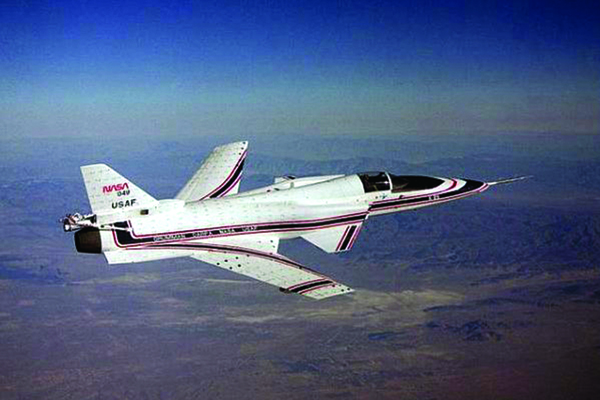Space History Photo: X-29 in Flight

In this 1984 historical photo from the U.S. space agency, the X-29 Flight Research Aircraft features one of the most unusual designs in aviation history. Demonstrating forward swept wing technology, this aircraft investigated numerous advanced aviation concepts and technologies.
The fighter-size X-29 explored the use of advanced composites in aircraft construction, variable camber wing surfaces, an unique forward-swept-wing and its thin supercritical airfoil, and strake flaps. The X-29 also demonstrated three specific aerodynamic effects: canard effects, active controls, and aeroelastic tailoring. Canard effects use canards (small wings) to function as another control surface to manipulate air flow. Active controls enable an airplane to pull air across the plane in specific directions rather than passively letting the air flow over it. Aeroelastic tailoring allows parts of an aircraft to flex slightly when air hits it in a certain way to allow for maximum flexibility of air flow.
Although the X-29 was one of the most instable of the X-series in maneuvering capabilities, it was controlled by a computerized fly-by-wire flight control system that overcame the instability going further than any other aircraft testing the limits of computer controls. The first flight was December 14, 1984.
Each weekday, SPACE.com looks back at the history of spaceflight through photos (archive).
Breaking space news, the latest updates on rocket launches, skywatching events and more!

The National Aeronautics and Space Administration (NASA) is the U.S. government agency in charge of the civilian space program as well as aeronautics and aerospace research. Founded in 1958, NASA is a civilian space agency aimed at exploring the universe with space telescopes, satellites, robotic spacecraft, astronauts and more. The space agency has 10 major centers based across the U.S. and launches robotic and crewed missions from the Kennedy Space Center in Cape Canaveral Florida. Its astronaut corps is based at the Johnson Space Center in Houston. To follow NASA's latest mission, follow the space agency on Twitter or any other social channel, visit: nasa.gov.
